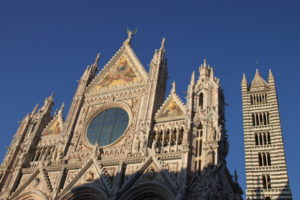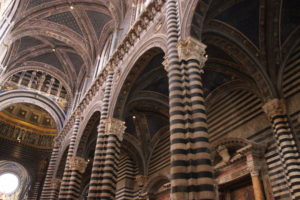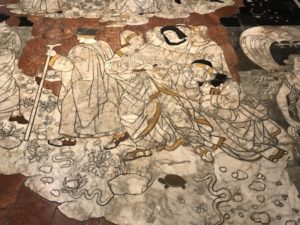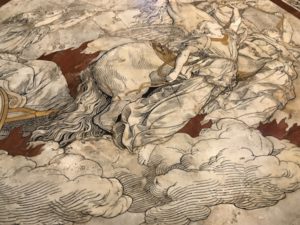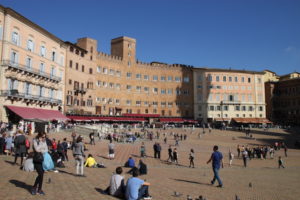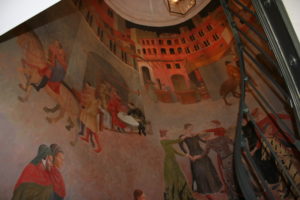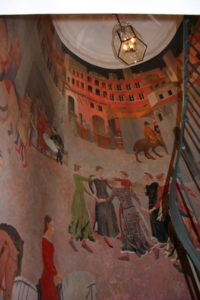UNESCO says that Siena’s historic center “is the embodiment of a medieval city. … The whole city of Siena was devised as a work of art that blends into the surrounding landscape.”
I couldn’t have explained it better myself, the reason I found Siena so appealing during a long-ago visit. I was determined to return and managed that with three friends this past October (2018).
Siena, at its heart, is a walled hill town — sited on three hills, not just one — in Italy’s Tuscany. Its four-plus miles of fortified walls still stand, embracing the 420-acre town center.

View of the Siena cityscape with the cathedral in the background, perched atop one of the city’s three hills.

Late-day view of the Siena skyline, in this case highlighted by the tower on the town hall building that sits on il Campo at the heart of the UNESCO-protected historic Siena.
A UNESCO World Heritage Site and, since 1965, mostly traffic free, old Siena acquired its Gothic appearance between the 12th and 15th centuries. That means it has the same street plan and looks roughly the way it looked when Columbus was sailing the ocean blue.
Although I had an idea of Siena’s charms, especially at the cathedral, the city and the cathedral had a couple of surprises in store for me last fall.
Watch your step
The Siena Cathedral’s facade, built in the 13th/14th centuries, is gorgeous, featuring ornately decorated white marble with some stones of other colors (Siena red marble and Prato serpentine, per visittuscany.com). It’s really hard to describe — maybe call it a birthday cake.
Visittuscany.com says the bottom half is Romanesque-Gothic style, and the higher is Florentine Gothic. I don’t know the difference, so I refer you to the photos!

A similar view of the Siena Cathedral, seen at midday. While white marble predominates on the facade, the red marble is seen as part of the arches.
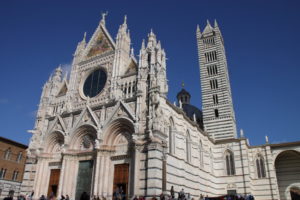
View of the Siena Cathedral and a tower notable for horizontal stripes created with two colors of stone.
From my first visit in 1986, I had remembered the Siena Cathedral interior because of the horizontally striped pillars, a look created with alternating colors of black and white stone.
There also are countless frescoes, particularly notable around the altar area, and there are the Renaissance frescoes in a side room, the Biblioteca Piccolomini. Further, in the library, the walls, at eye level, are lined with incredibly beautiful examples of medieval Bibles that feature an artist’s handiwork on every page.
But the real surprise was the floor, covered with 56 inlaid marble mosaic artworks, telling mythological and Biblical stories. The marble panels were designed by 40 artists between 1369 and 1547. I had not remembered the floors, and apparently for a good reason.
For their protection, Siena’s cathedral floors are covered most of the year, but uncovered for viewing in July, then again from late August through October. We got lucky.
Even when exposed, each themed panel is roped off so no one is ever actually walking on these mosaics.

Marble mosaics on the cathedral floor graphically illustrate the “Slaughter of the Innocents,” referring to King Herod’s wish at the time of Christ’s birth to destroy the rumored newborn king.
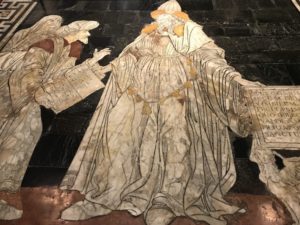
Another of the 56 scenes created by Sienese artists in marble: Moses receiving the Ten Commandments.
‘Good Government’ inspiration
After the shock (in the best sense) of seeing the cathedral interior and especially the mosaic floors, my friends and I headed to the Piazza del Campo, aka il Campo, nearby, for lunch.
Il Campo, meaning the Field, was constructed in the 12th century in a valley where the three major streets that connect Siena’s three hills intersect.
It is the city’s main square, but is shaped like a shell. The shell is divided into nine wedge-shaped sections, each paved with a different brick pattern, to represent the Government of Nine that once managed the city.
Il Campo functions as a kind of brick Central Park, with lots of people hanging out, sitting in clusters on the bricks, sunbathing, etc. This “field” slopes significantly, with the early-14th century city hall abutting its lowest point.
Il Campo also is the scene of Siena’s twice-a-year horse race, called the Palio di Siena, which pits the city’s districts (contradas) against one another.
My goal, after an idyllically sited lunch on the square, was the Civic Museum, located inside part of the still-active city hall. The museum encompasses the spaces once used by the medieval city’s managers.
The museum features frescoes and other artworks that originated across several centuries, but the eye grabbers for me were a chapel and the room where Siena’s nine governors met in the 14th century.
The chapel, richly endowed with meaningful frescoes, was built as soon as the 1348 Black Death stopped decimating the city. Builders were grateful for the end to a scourge that took anywhere from a third to 80% of residents; estimates vary widely, to say the least.
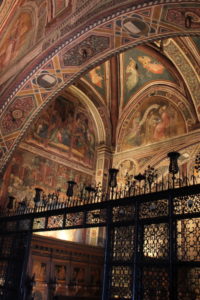
Chapel constructed inside the city hall after the 14th century Black Death had stopped killing the Sienese. This section of the still-active city hall is now part of the city’s Civic Museum.
The Hall of Peace, where the nine governors met, is known for a series of frescoes called “Allegory of Good and Bad Government,” which show on one wall happy scenes meant to illustrate the effects of good governance, paired with unhappy scenes on the opposite wall meant to illustrate bad governance.

Above, the best-known scene, illustrating the effects of good governance, from a series of frescoes called “The Allegory of Good and Bad Government” found in Siena’s Civic Museum. Below, a closer view of the dancing girls found in this fresco series.
I was stunned when I recognized one of the good government scenes, but not based on a previous visit.
It was the basis for a huge painting created more than 20 years ago by an artist friend, Liam Roberts, working on commission for the owners of an apartment in New York City.
I had known that Liam traveled to Italy as part of his research, but I had not known the inspiration for the dancing women and other figures that appeared on a two-story-high wall in the New York duplex. Now I do — and what a great place to do research!
I am including photos of the original Sienese work and Liam’s version of it. When he is not working to a buyer’s specifications, he produces a widely varied collection of art, seen at www.liamroberts.com and on Instagram at liamrobertsnyc.

Above and below, sections of the Sienese fresco reimagined to create a mural that wraps around a spiral staircase in a private residence. The artist is Liam Roberts (www.liamroberts.com; Instagram: liamrobertsnyc).
For more about Tuscany, we offer at BestTripChoices.com the following, under the headline, Medieval walls, Chianti wine: https://besttripchoices.com/international-touring-areas/tuscanyhill-towns-italy/
This blog and its photos are by Nadine Godwin, BestTripChoices.com editorial director and contributor to the trade newspaper, Travel Weekly. She also is the author of “Travia: The Ultimate Book of Travel Trivia.”
.

